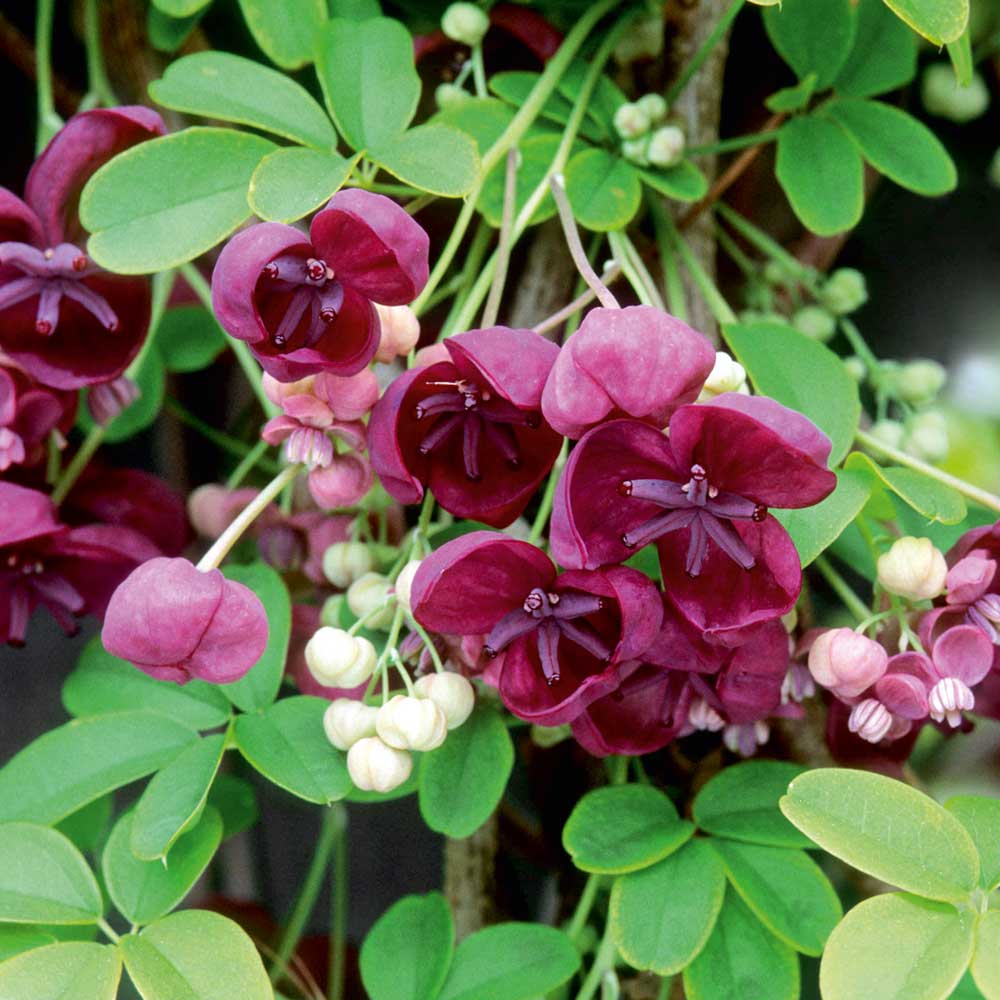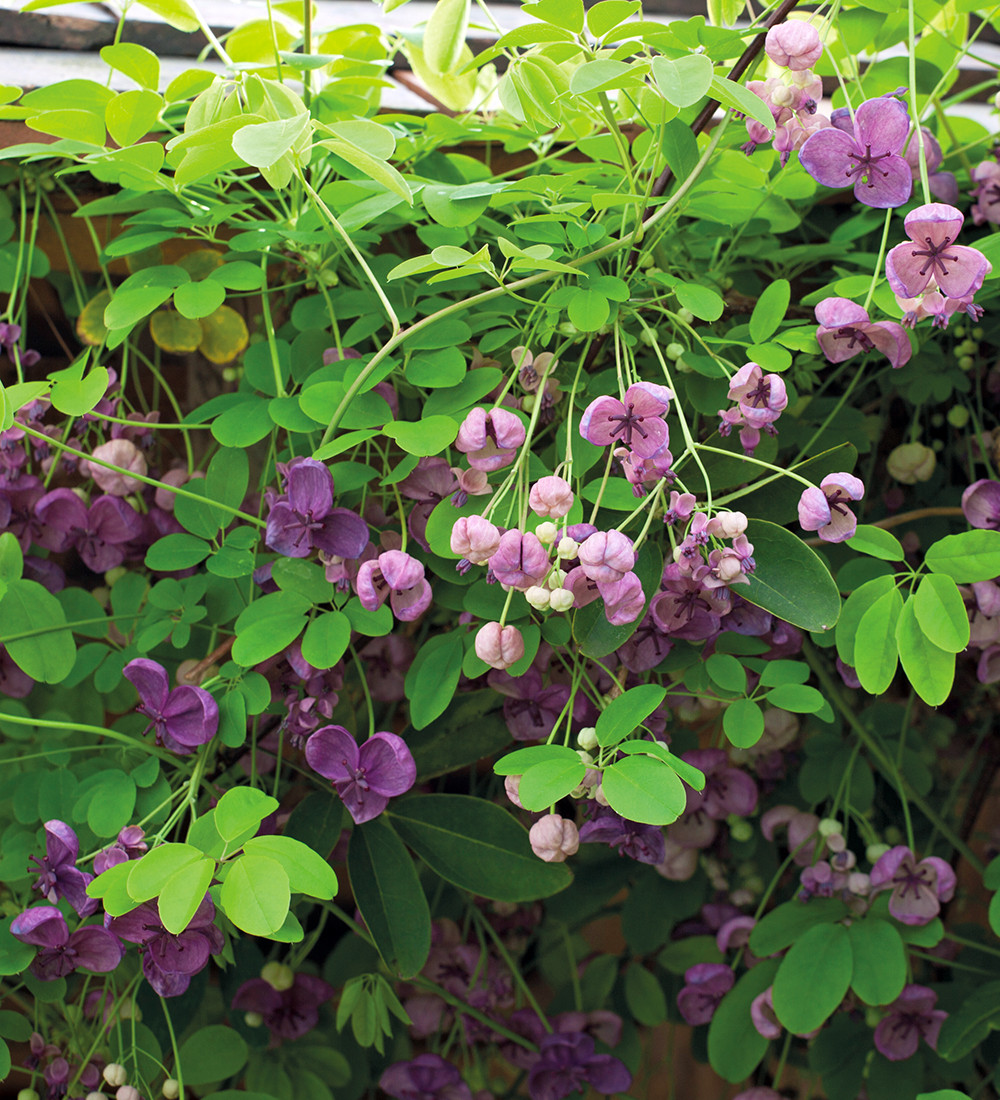1Garden.com

1Garden.com – Grow Your Gardening Knowledge

Plant Profile:
Akebia quinata (Chocolate Vine)
The Akebia quinata, commonly known as the Chocolate Vine, is a vigorous and versatile climbing plant that can add a touch of elegance to any garden. With its attractive foliage, fragrant flowers, and unique fruit, this plant is sure to be a standout feature in your outdoor space.
Where can I buy?
Dobies
Sarah Raven
Suttons
Thompson & Morgan
Source:- Youtube – @Tropical Gardening

Dobies.co.uk

Dobies.co.uk

Dobies.co.uk

Sarahraven.com

Dobies.co.uk

Suttons.co.uk

Suttons.co.uk

Suttons.co.uk

Suttons.co.uk
Plant Size
The ultimate height of the Akebia quinata can reach up to 20 feet (6 meters), while the ultimate spread can extend to around 10 feet (3 meters). It typically takes several years for the plant to reach its ultimate height, so patience is key when cultivating this vine.
Ideal Soil Conditions
The Akebia quinata thrives in well-draining soil that is rich in organic matter. It can adapt to a range of soil types, including loam, sand, and clay. It prefers a slightly acidic to neutral pH level, ideally between 5.5 and 7.5. Adequate moisture is important for the plant’s growth, so ensure the soil remains consistently moist but not waterlogged.
Flowering and Fruit Production
The Chocolate Vine produces small, dark purple flowers that have a delightful chocolate-like fragrance. These blooms typically appear in early spring, around April or May, depending on the climate. The flowers are followed by intriguing elongated fruit pods, which ripen in late summer or early fall. The fruit is edible and has a sweet, gelatinous pulp, making it a popular choice for culinary purposes.
Positioning
The Akebia quinata thrives in full sun to partial shade. It prefers a position that receives at least 4-6 hours of direct sunlight each day but can also tolerate some shade. It is important to provide the plant with a sturdy support structure, such as a trellis or pergola, as it is a climbing vine.
Botanical Details
The Akebia quinata belongs to the Lardizabalaceae family and the Akebia genus. It is native to East Asia and is commonly found in countries like Japan, China, and Korea. This evergreen or semi-evergreen vine is known for its twining stems and palmate leaves, which consist of five leaflets.
How to Grow
Cultivation
To cultivate the Akebia quinata, start by preparing the soil by incorporating organic matter and ensuring proper drainage. Dig a hole that is slightly larger than the plant’s root ball and place the vine in the hole. Backfill with soil and gently firm it around the base of the plant. Water thoroughly after planting and continue to provide regular watering during the first growing season.
Propagation
The Chocolate Vine can be propagated through various methods, including seed sowing, stem cuttings, and layering. Sow seeds in spring or take semi-ripe stem cuttings in summer. Layering can be done by bending a low-growing stem to the ground, securing it with a U-shaped wire, and covering it with soil. After a year, the layered stem can be separated from the parent plant and transplanted.
Suggested Planting Locations and Garden Type
The Akebia quinata is well-suited for various garden styles, including cottage gardens, woodland gardens, and even urban gardens with limited space. It can be grown against walls, fences, or pergolas, where its climbing nature can be showcased. Its lush foliage and fragrant flowers make it an excellent choice for adding vertical interest and a touch of elegance to any garden.
Pruning
Pruning is an essential part of maintaining the Akebia quinata. It is best to prune the vine in late winter or early spring before new growth begins. Remove any dead, damaged, or crossing branches to maintain a healthy and well-shaped plant. Additionally, pruning can help control the size and prevent the vine from becoming too invasive.
Pests & Diseases
The Chocolate Vine is generally resistant to most pests and diseases. However, it may occasionally be susceptible to aphid infestations or fungal diseases such as powdery mildew. Regular monitoring and proper maintenance, including providing adequate air circulation and avoiding over-watering, can help prevent and manage these issues.
Frequently Asked Questions
Is the fruit of the Akebia quinata edible?
Yes, the fruit of the Chocolate Vine is edible and has a sweet, gelatinous pulp. It is often used in Asian cuisines for its unique flavour.
Can the Akebia quinata be grown in containers?
While the Akebia quinata is primarily a climbing vine, it can be grown in large containers with proper support. Ensure the container is deep enough to accommodate the plant’s root system and provide a trellis or other structure for the vine to climb.
Does the Akebia quinata attract pollinators?
Yes, the fragrant flowers of the Akebia quinata attract bees and other pollinators, making it a valuable addition to a pollinator-friendly garden.
How fast does the Akebia quinata grow?
The growth rate of the Akebia quinata can vary depending on the growing conditions. Under ideal conditions, it can grow around 1-2 feet (30-60 cm) per year.
Can the Akebia quinata be invasive?
While the Akebia quinata can be vigorous in its growth, it is not considered invasive in most regions. However, it is always a good practice to monitor its growth and prevent it from spreading to unwanted areas by regular pruning and maintenance.















The post Plant Profile: Akebia quinata (Chocolate Vine) – A Vigorous and Versatile Climbing Plant for Your Garden first appeared on 1Garden.com and is written by 1Garden.com


